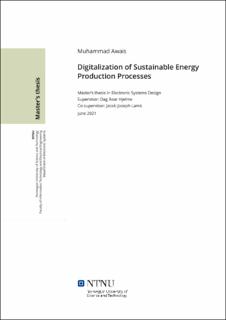| dc.description.abstract | Biogas production is growing as a renewable energy source. In order to maximize energy production, it is essential to ensure that the production process is economical and efficient. This report discusses the anaerobic digestion (AD) process, which breaks down organic material with the help of microorganisms in the absence of oxygen, and the parameters involved in sensing of VFAs in the digester. It also covers the sensor characteristics required for the sensor to function in the biogas production process and how it works and is suitable for monitoring VFAs in the AD process. Volatile Fatty Acids (VFAs) are an intermediate compound made during the AD process, and their concentration influences the production process. In addition, their concentration can indicate the state of the biological process, with high VFA concentrations signifying biological deterioration within the process in terms of biological stability and feedstock overloading. Several traditional methods can measure and classify VFAs during the AD process to maintain stability and high efficiency. Despite this, these traditional methods are not fast, and usually, a trade-off has to be made between robustness and selectivity of the VFA detection. Here, an emerging technology for chemical sensing is suggested based on an optical sensor array to overcome these shortfalls. This sensor technology mimics the human olfactory system by having dyes instead of receptors in a nose to detect any smell in the environment and be sensitive to dilute concentrations.
By using dyes and image processing, it may be possible to detect and classify VFAs. This is achieved by assessing the interaction between the analyte (VFAs) and the dyes in terms of the observable color changes. The 21-dye colorimetric sensor array was evaluated experimentally to exhibit color change after interacting with VFAs. The color change of before and after image results in data in the form of a vector. However, this vector is high-dimensional data and is not readable. Therefore, data analysis and modeling tools must be used to interpret the optical sensor array to extract the information regarding the VFA presence. Several modeling methods can be used and are discussed with their pros and cons within this report. The main objective of this project is the development and testing of a sensor system that senses and classifies VFAs in AD to indicate process deterioration in a robust, low-cost, and automatic manner. The experiment shows that the sensor developed in this project provides the desired sensitivity and selectivity required to detect VFAs in the AD process. Sensitivity tests and mixed VFAs in different concentrations were used to examine the sensor system. The sensor was able to detect all types of mixed samples of all concentration levels low & high. | |
